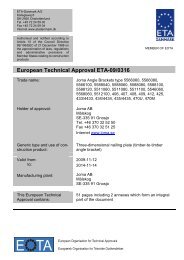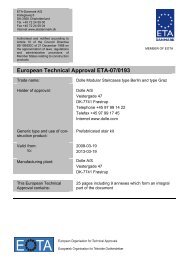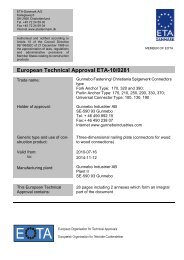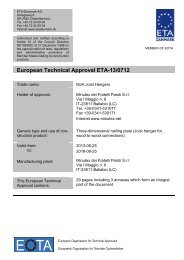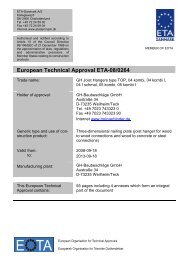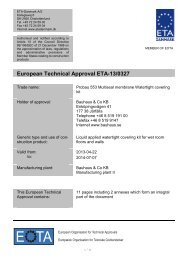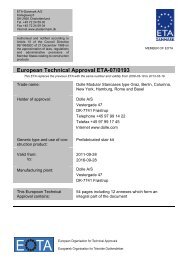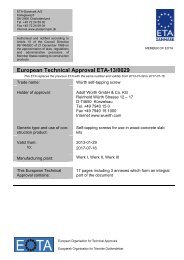European Technical Approval ETA-09/0363 - ETA-Danmark
European Technical Approval ETA-09/0363 - ETA-Danmark
European Technical Approval ETA-09/0363 - ETA-Danmark
Create successful ePaper yourself
Turn your PDF publications into a flip-book with our unique Google optimized e-Paper software.
Page 9 of 31 of <strong>European</strong> <strong>Technical</strong> <strong>Approval</strong> no. <strong>ETA</strong>-<strong>09</strong>/<strong>0363</strong><br />
4 Assumptions under which the fitness of the<br />
product for the intended use was favourably<br />
assessed<br />
4.1 Manufacturing<br />
Würth joist hangers types convex angled 2 mm, Joist<br />
Hangers inwardly angled 2 mm and Joist Hangers two parts<br />
2 mm are manufactured in accordance with the provisions<br />
of this <strong>European</strong> <strong>Technical</strong> <strong>Approval</strong> using the<br />
manufacturing processes as identified in the inspection of<br />
the plant by the notified inspection body and laid down in<br />
the technical documentation.<br />
4.2 Installation<br />
Joist hanger connections<br />
A joist hanger connection is deemed fit for its intended use<br />
provided:<br />
Header – support conditions<br />
• The header beam shall be restrained against rotation<br />
and be free from wane under the joist hanger.<br />
If the header carries joists only on one side the<br />
eccentricity moment from the joists Mec = Rjoist<br />
(bheader/2+eJ,0) shall be considered at the strength<br />
verification of the header.<br />
Rjoist Reaction force from the joists<br />
bheader Width of header<br />
eJ,0 Distance from the centroid of the nails in<br />
the joist to the surface of the header<br />
• For a header with joists from both sides but with<br />
different reaction forces a similar consideration<br />
applies.<br />
Wood to wood connections<br />
• Joist hangers are fastened to wood-based members<br />
by nails.<br />
• There shall be nails in all holes or a partial nailing<br />
pattern as prescribed in Annex A-D may be used.<br />
• The characteristic capacity of the joist hanger<br />
connection is calculated according to the<br />
manufacturer’s technical documentation, dated 2008-<br />
11-22.<br />
• The joist hanger connection is designed in<br />
accordance with Eurocode 5 or an appropriate<br />
national code.<br />
• The gap between the end of the joist and the surface,<br />
where contact stresses can occur during loading shall<br />
be limited. This means that for joist hangers with<br />
outward flaps the gap between the surface of the end<br />
of the joist and that of the header shall be maximum<br />
3 mm.<br />
Joist hangers with inward flaps the gap between the<br />
surface of the nail heads in the inward flaps and the<br />
end of the joist shall be maximum 8 mm.<br />
• For joist hangers convex angled 2 mm, Joist Hangers<br />
inwardly angled 2 mm and Joist Hangers two parts 2<br />
mm the width of the joist shall be at least l+4d,<br />
where l is the length of the fasteners and d is the<br />
fastener diameter in the joist, for full nailing and<br />
partial nailing without staggering the fasteners in the<br />
joist. For nailing with staggered fasteners in the joist<br />
the width shall be at least the penetration length of<br />
the fasteners.<br />
• The cross section of the joist at the joist hanger<br />
connection shall have sharp edges at the lower side<br />
against the bottom plate, i.e. it shall be without wane.<br />
• The cross section of the header shall have a plane<br />
surface against the whole joist hanger.<br />
• The width BJ of the joist shall correspond to that of<br />
the joist hanger. BJ shall not be smaller than B-3 mm,<br />
where B is the inner width of the joist hanger.<br />
• The depth of the joist shall be so large that the top of<br />
the joist is at least 20 mm above the upper fastener in<br />
the joist.<br />
• Nails to be used shall have a diameter, which fits the<br />
holes of the joist hangers.<br />
Wood to concrete or steel<br />
The above mentioned rules for wood to wood connections<br />
are applicable also for the connection between the joist and<br />
the joist hanger.<br />
• The joist hanger shall be in close contact with the<br />
concrete or steel over the whole face. There shall be<br />
no intermediate layers in between.<br />
• The gap between the end of the joist and the surface,<br />
where contact stresses can occur during loading shall<br />
be limited. This means that the gap between the<br />
surface of the end of the joist and that of the concrete<br />
or steel shall be maximum 3 mm.<br />
• The bolt shall have a diameter not less than the hole<br />
diameter minus 2 mm.<br />
• The bolts shall be placed symmetrically about the<br />
vertical symmetry line. There shall always be bolts in<br />
the 2 upper holes.<br />
• The upper bolts shall have washers according to EN<br />
ISO 7<strong>09</strong>4.<br />
4.3 Maintenance and repair<br />
Maintenance is not required during the assumed intended<br />
working life. Should repair prove necessary, it is normal to<br />
replace the angle bracket.<br />
Thomas Bruun<br />
Manager, <strong>ETA</strong>-<strong>Danmark</strong>




